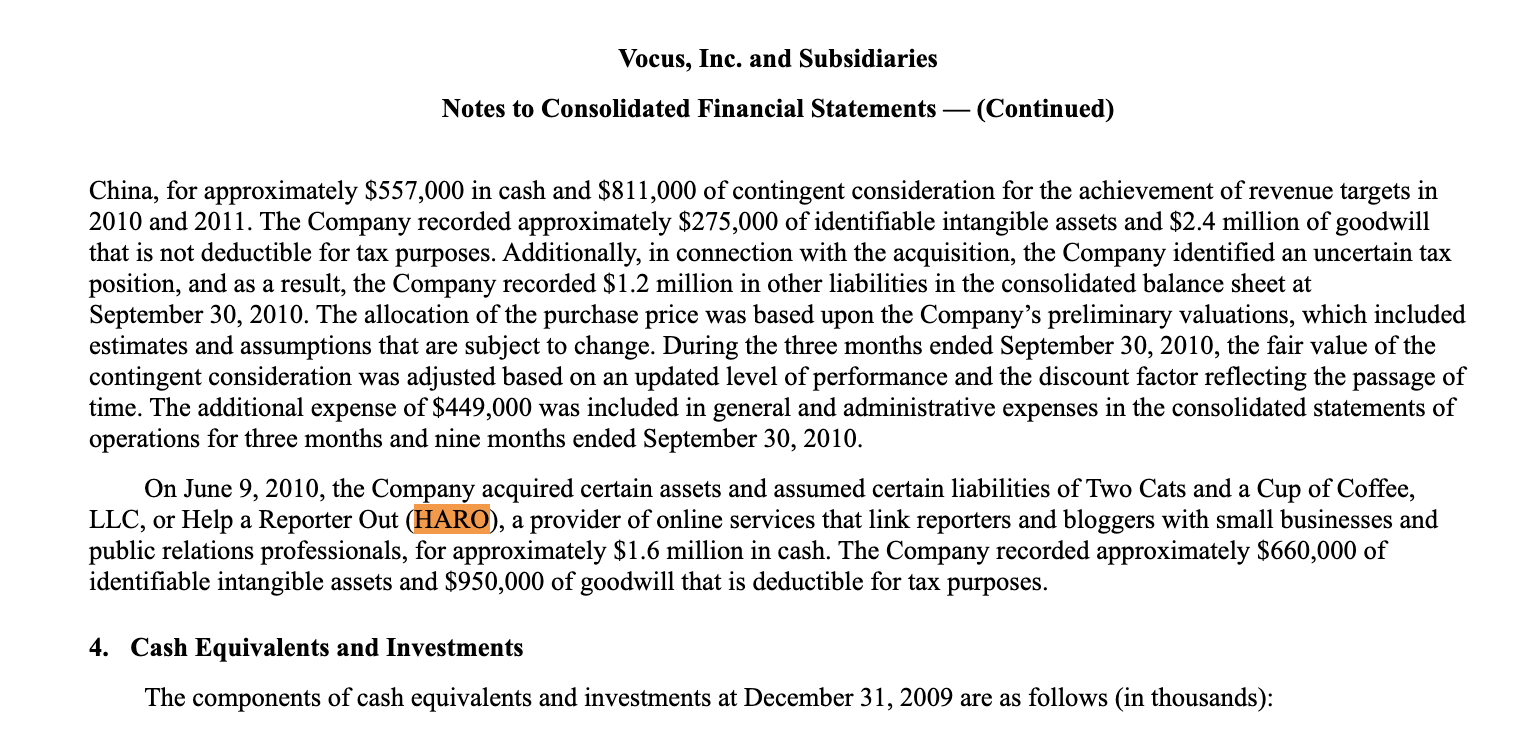Connectively (former HARO or Help a Reporter Out) is shutting down on December 9, 2024.
In the end, economics and simple math caught up to the platform.
The business model with Help a Reporter Out was originally newsletter ads. The business generated $1M a year in revenue before being acquired by Vocus for $1.6M in cash in 2010.
HARO Acquired By Vocus
Vocus had raised $45M in a public offering in 2005. $5M went to accounting and legal firms. $6.8M went to repay certain indebtedness. $20.9M went to the acquisition of PRWeb. And then the company went on a $11.8M acquisition spree in the three months ending around June 30, 2010, acquiring Datapresse ($9.7M), BDL Media ($0.5M), and HARO ($1.6M).
These acquisitions were at a time when Vocus was generating about $94M in annual revenues, and operating with a $4M a year net loss.
In other words, Vocus used about 3.5% of total capital raised to acquire HARO. The acquisition was likely for lead generation, since Vocus spent about $48.5M a year in Sales and Marketing (or about 60% of their total operating expenses) and was operating at a loss.
Vocus simply needed a more cost effective way to acquire customers.
A risk statement in the Vocus 2010 10-K filing with the SEC seems to support this line of thinking:
“One of our business strategies is to selectively acquire companies which would either expand our solutions’ functionality, provide access to new customers or markets, or both.”
In other words, the thinking may have been, “own HARO, and upsell users to Vocus services.”
When HARO was operating independently, 100% of the business focus was on HARO and the service was 100% amazing as a result.
Through acquisition, HARO now made up 1% of the company’s revenues. How did the business strategy work for Vocus, in terms of converting users to customers?
Well, the GAAP Revenue for Vocus in 2013 was $186.9M, almost doubling from the time of the HARO acquisition. While this growth may have been largely attributable to other aspects of the business, the strategy of using HARO to grow Vocus may have worked for several years.
Then, Vocus was acquired by GTCR, a Chicago private equity firm for $446.5M and merged with CISION to become the leader in PR software.
Vocus Merges with CISION
In the official press release announcing the Cision and Vocus merger, HARO gets a couple of mentions alongside PRWeb, iContact, and the Visible brands.
However, this merger likely was the beginning of the end for HARO. It’s just simple math.
With Vocus, HARO made up 1% of revenue. However, if you’re a million dollar service within a billion dollar organization, your service makes up 0.1%.
The service requires resources to run and operate, ultimately detracting from the core parts of a business that generates 99.9% of your revenues and profits.
Sure, there’s other contributions the service can make like “goodwill” and “brand” and “upsells.” But, it’s very different being a $1M service in a company where revenues make up 1% versus 0.1%.
Ultimately, HARO was rebranded to Connectively. Subsequently, the goodwill and brand benefits were lost. Upselling customers likely went to zero after a decade of strategy execution. And it became more advantageous for the company to focus efforts on CisionOne than on Connectively.
What’s Next?
Before jumping into what’s next, it feels right to take a moment and give a hat tip to all that HARO accomplished.
HARO saw a need to connect media with sources. It was the first service to market, and serviced more than 1M sources and 75,000 members of the media. Even today, almost seventeen years later, I can see on a Zoom call when someone is about to get nostalgic and remember the days when they answered media queries via email.
They always recall the early days of HARO fondly. That’s because HARO was fun, and made a huge impact for the businesses that used the service.
Now, many Connectively users are asking themselves what’s next. They’re asking themselves what the HARO alternatives are, and where they should move to now that Connectively has shut down.
While replicating the early days of HARO will never be achieved, here’s a list of Connectively / HARO alternatives that connect media with sources:
- Featured.com (Full disclosure: I’m the founder of Featured.com.)
- HelpaB2BWriter Out
- Sources of Sources
- Qwoted
- SourceBottle
- #JournoRequest
- ProfNet
- + and more
The good news is that sourcing experts for stories is an infinite problem that journalists face, and everyone has expertise to share.
Thanks to HARO (and all those who worked on it) for paving the way to share knowledge and enhance the information that readers can learn from.
